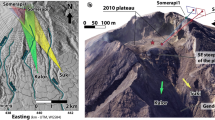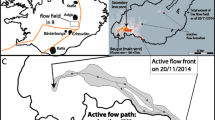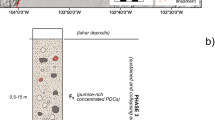Abstract
The extrusion of lava domes, their potential collapse, and subsequent pyroclastic flows represent volcanic hazards. Using high-resolution time-lapse images and numerical modeling, we study here the morphological changes of the lava dome formed at Volcán de Colima between February and March 2013 and assess the rheological properties of the dome controlling the growth. Our models of lava dome growth at the volcano incorporates the crystal growth kinetics and realistic topography of the crater floor. We consider several scenarios of the dome growth with different conduit shape and the crater geometry, initial and equilibrium crystal content, and viscosity to analyze the model parameters controlling the morphology of the growing dome. The initially steep vertical growth and subsequent lateral growth are well captured by numerical modeling. The height of a lava dome depends essentially on the lava viscosity and the effusion rate. Due to the interplay between the lava extrusion rate and the gravity, the dome reaches a height threshold, and after that a horizontal gravity spreading plays an essential role in the lava dome evolution. The viscosity of the lava dome (about 1010.8 Pa s) is higher by about an order of the magnitude than the apparent viscosity of lavas from Volcán de Colima estimated experimentally, although the lava dome’s core is less crystallized and hence its viscosity is about 1010.4 Pa s.









Similar content being viewed by others
REFERENCES
Belousov, A., Belousova, M., and Voight, B., Multiple edifice failures, debris avalanches and associated eruptions in the Holocene history of Shiveluch volcano, Kamchatka, Russia, Bull. Volcanol., 1999, vol. 61, no. 5, pp. 324–342.
Bretón-Gonzalez, M., Campos, A., Leon, Z., et al., The 2007–2012 lava dome growth in the crater of Volcán de Colima, México, derived from video monitoring system, in Complex Monitoring of Volcanic Activity, Zobin, V.M., Ed., N.Y.: Nova Science Publishers, Inc., 2013, pp. 153–169.
Chevrel, M. O., Platz, T., Hauber, E., Baratoux, D., Lavallée, Y., and Dingwell, D.B., Lava flow rheology: A comparison of morphological and petrological methods, Earth Planet. Sci. Lett., 2013, vol. 384, pp. 109–120.
Costa, A., Caricchi, L., and Bagdassarov, N., A model for the rheology of particle-bearing suspensions and partially molten tocks, Geochem. Geophys. Geosys., 2009, vol. 10, no. 3, Q03010.
Hale, A.J., Calder, E.S., Loughlin, S.C., Wadge, G., and Ryan, G.A., Modelling the lava dome extruded at Soufriere Hills Volcano, Montserrat, August 2005–May 2006. Part II: Rockfall activity and talus deformation, J. Volcanol. Geotherm. Res., 2009, vol. 187, nos. 1–2, pp. 69–84.
Hirt, C.W. and Nichols, B.D., Volume of fluid (VOF) method for the dynamics of free boundaries, J. Comput. Phys., 1981, vol. 39, no. 1, pp. 201–225.
Hooper, D.M. and Mattioli, G.S., Kinematic modeling of pyroclastic flows produced by gravitational dome collapse at Soufriere Hills volcano, Montserrat, Nat. Hazards, 2001, vol. 23, no. 1, pp. 65–86.
Husain, T., Ellsworth, D., Voight, B., Mattioli, G., and Jansma, P., Influence of extrusion rate and magma rheology on the growth of lava domes: Insights from particle-dynamics modeling, J. Volcanol. Geotherm. Res., 2014, vol. 285, pp. 100–117.
Ismail-Zadeh, A. and Tackley, P., Computational Methods for Geodynamics, Cambridge: Cambridge Univ. Press, 2010.
Jeffrey, D. and Acrivos, A., The rheological properties of suspensions of rigid particles, AIChE J., 1976, vol. 22, pp. 417–432.
Lavallee, Y., Meredith, P.G., Dingwell, D.B., Hess, K.U., Wassermann, J., Cordonnier, B., Gerik, A., and Kruhl, J.H., Seismogenic lavas and explosive eruption forecasting, Nature, 2008, vol. 453, pp. 507–510.
Lejeune, A. and Richet, P., Rheology of crystal-bearing silicate melts: An experimental study at high viscosity, J. Geophys. Res., 1995, vol. 100. pp. 4215–4229.
Mardles, E., Viscosity of suspensions and the Einstein equation, Nature, 1940, vol. 145. pp. 970.
Melnik, O., and Sparks, R.S.J., Nonlinear dynamics of lava dome extrusion, Nature, 1999, vol. 402, pp. 37–41.
Nakada, S., and Motomura, Y., Petrology of the 1991–1995 eruption at Unzen: effusion pulsation and groundmass crystallization, J. Volcanol. Geotherm. Res., 1999, vol. 89, no. 1, pp. 173–196.
Patankar, S.V., and Spalding, D.B., A calculation procedure for heat and mass transfer in three−dimensional parabolic flows, Int. J. Heat Mass Transfer, 1972, vol. 15, pp. 1787−1806.
Peyret, R., Handbook of Computational Fluid Mechanics, N.Y.: Academic Press Limited, 1996.
Starodubtseva, Y.V., Starodubtsev, I.S., Ismail-Zadeh, A.T., et al., A method for magma viscosity assessment by lava dome morphology, J. Volcanolog. Seismol., 2021, vol. 15, pp. 159–168.
Tsepelev, I., Ismail-Zadeh, A., and Melnik, O., Lava dome morphology inferred from numerical modelling, Geophys. J. Inter., 2020, vol. 223, no. 3, pp. 1597–1609.
Walter, T. R., Harnett, C. E., Varley, N., et al., Imaging the 2013 explosive crater excavation and new dome formation at Volcan de Colima with TerraSAR-X, time-lapse cameras and modelling, J. Volcanol. Geotherm. Res., 2019, vol. 369, pp. 224–237.
Zobin, V.M., Arámbula, R., Bretón, M., et al., Dynamics of the January 2013–June 2014 explosive-effusive episode in the eruption of Volcán de Colima, México: insights from seismic and video monitoring, Bull. Volcanol., 2015, vol. 77, pp. 31. https://doi.org/10.1007/s00445-015-0917-z
Zorn, E.U., Le Corvec, N., Varley, N.R., et al., Load stress controls on directional lava dome growth at Volcán de Colima, Mexico, Front. Earth Sci., 2019, vol. 7, article 84. https://doi.org/10.3389/feart.2019.00084
ACKNOWLEDGMENTS
We are grateful to Vyacheslav Zobin and Alexander Soloviev for their insightful comments on the initial version of the manuscript. Numerical experiments were carried out on the URAN computing cluster (N.N. Krasovskii Institute of Mathematics and Mechanics, Ural Branch of the Russian Academy of Sciences, Yekaterinburg).
Funding
The work was supported by the Russian Science Foundation (project no. 19-17-00027).
Author information
Authors and Affiliations
Corresponding author
Ethics declarations
The authors declare that they have no conflicts of interest.
Rights and permissions
About this article
Cite this article
Tsepelev, I.A., Ismail-Zadeh, A.T. & Melnik, O.E. Lava Dome Evolution at Volcán de Colima, México During 2013: Insights from Numerical Modeling. J. Volcanolog. Seismol. 15, 491–501 (2021). https://doi.org/10.1134/S0742046321060117
Received:
Revised:
Accepted:
Published:
Issue Date:
DOI: https://doi.org/10.1134/S0742046321060117




